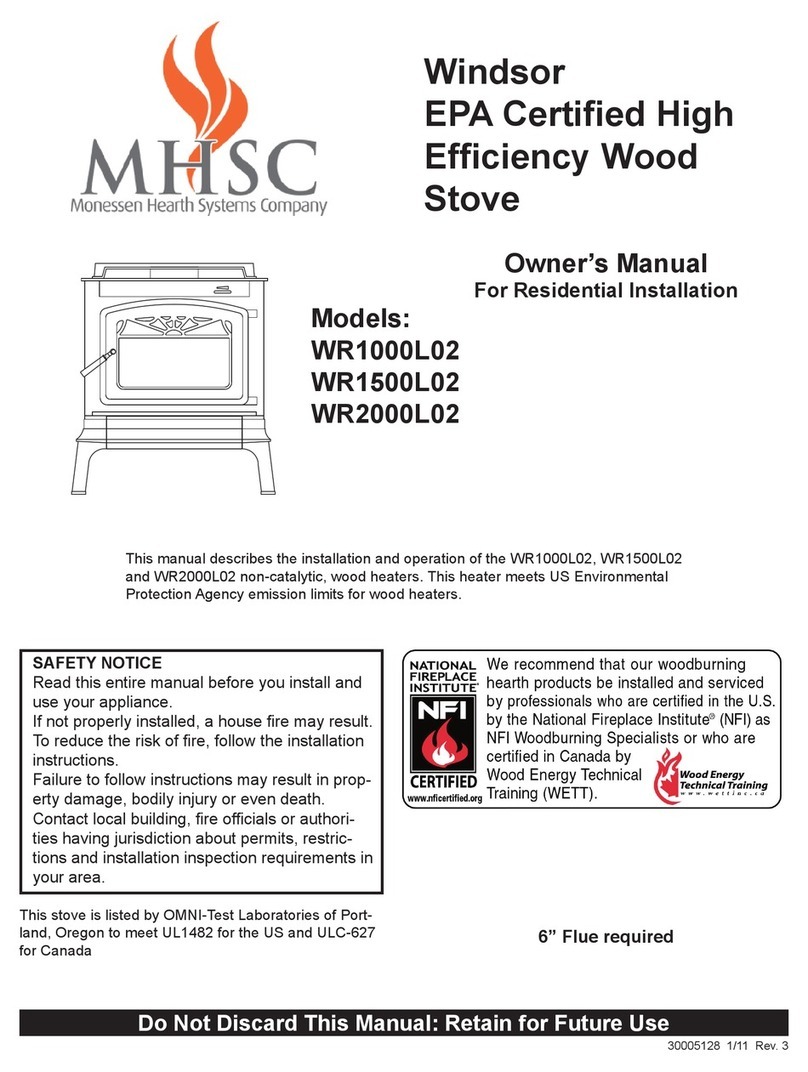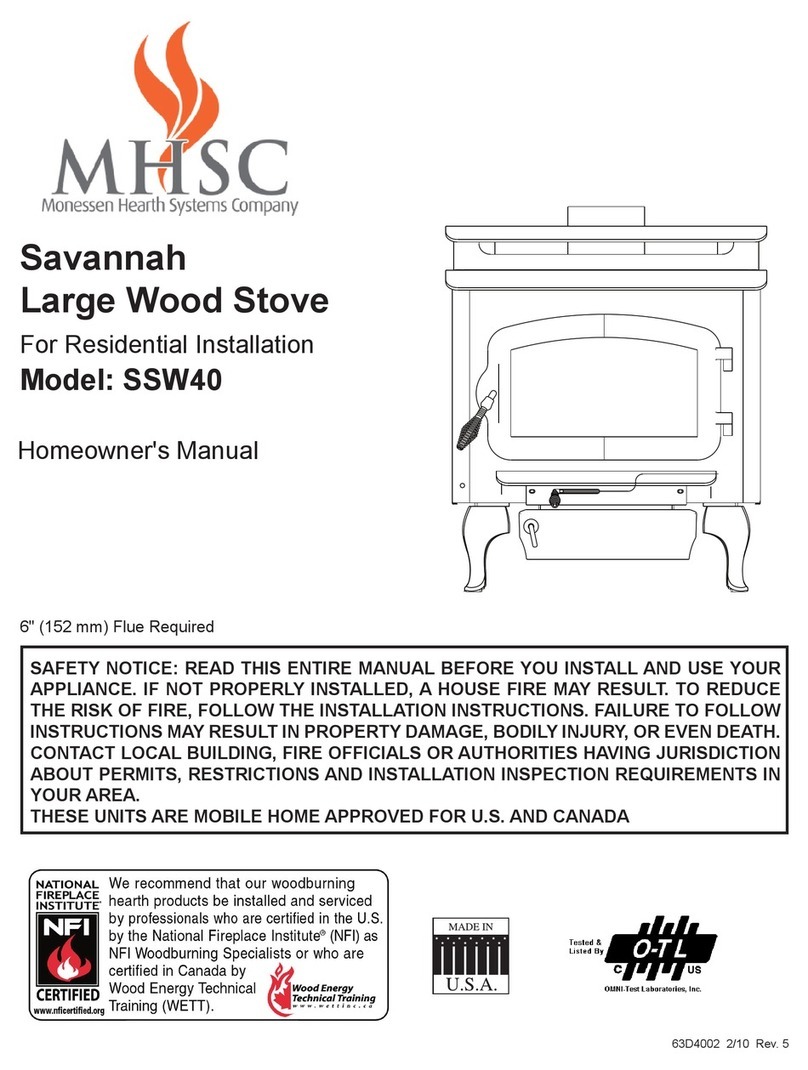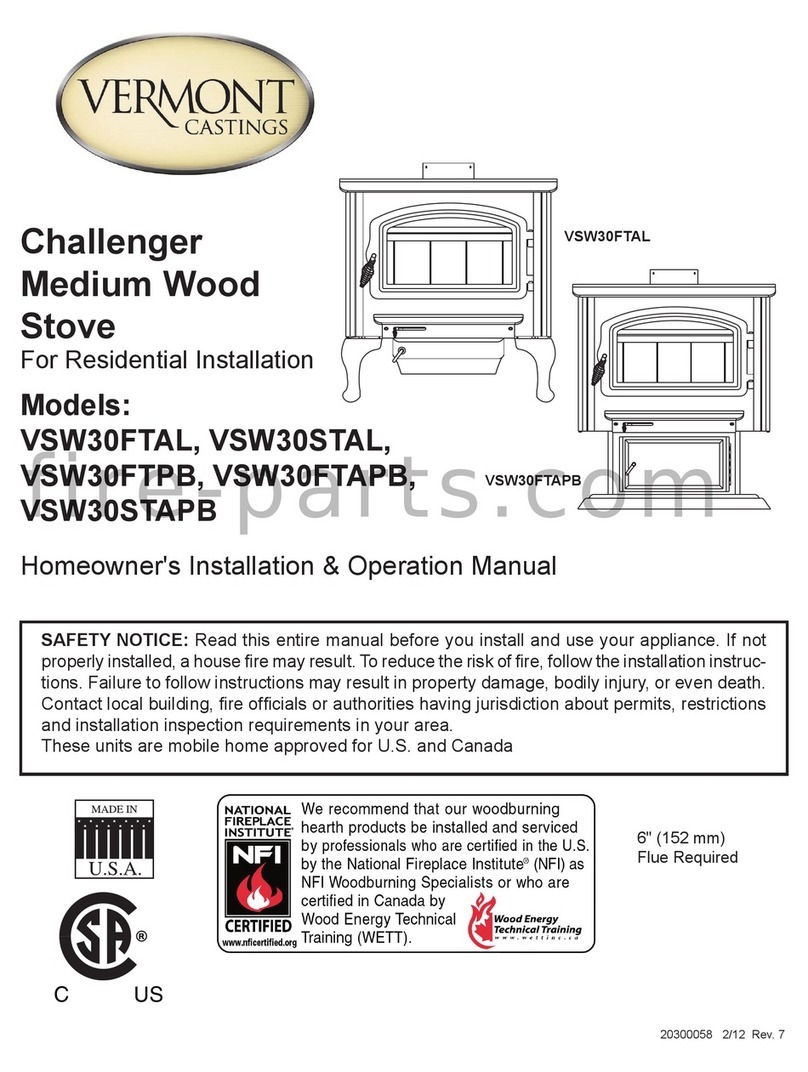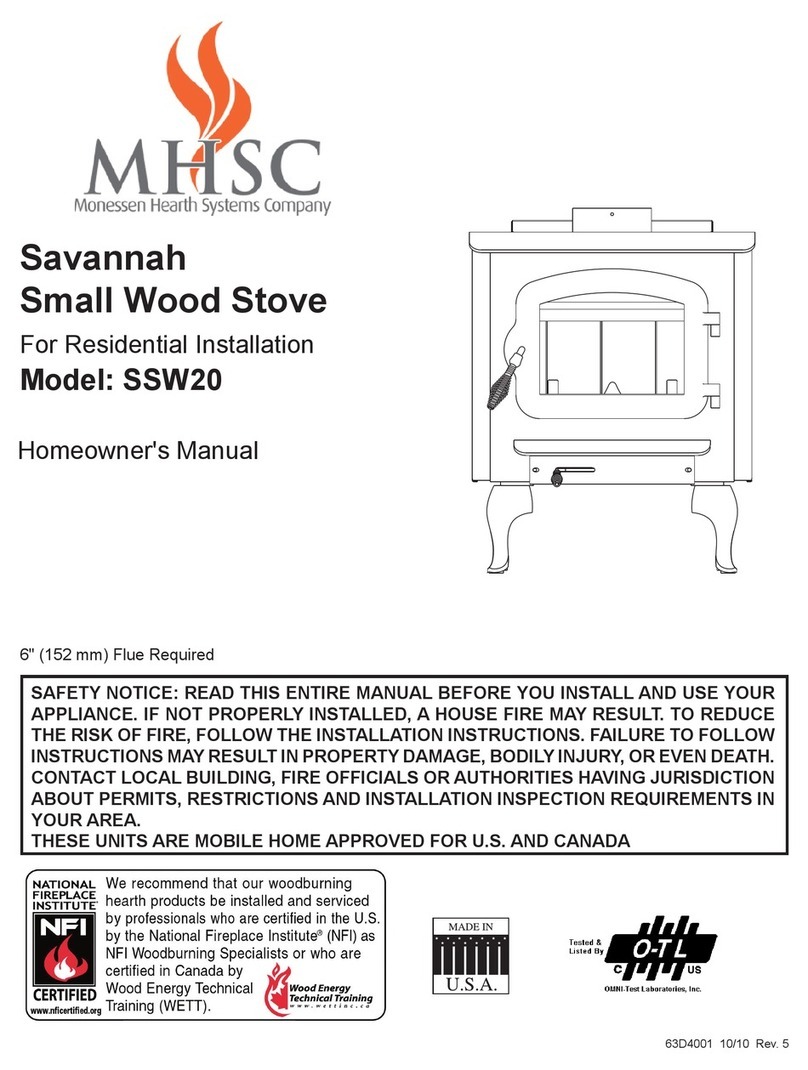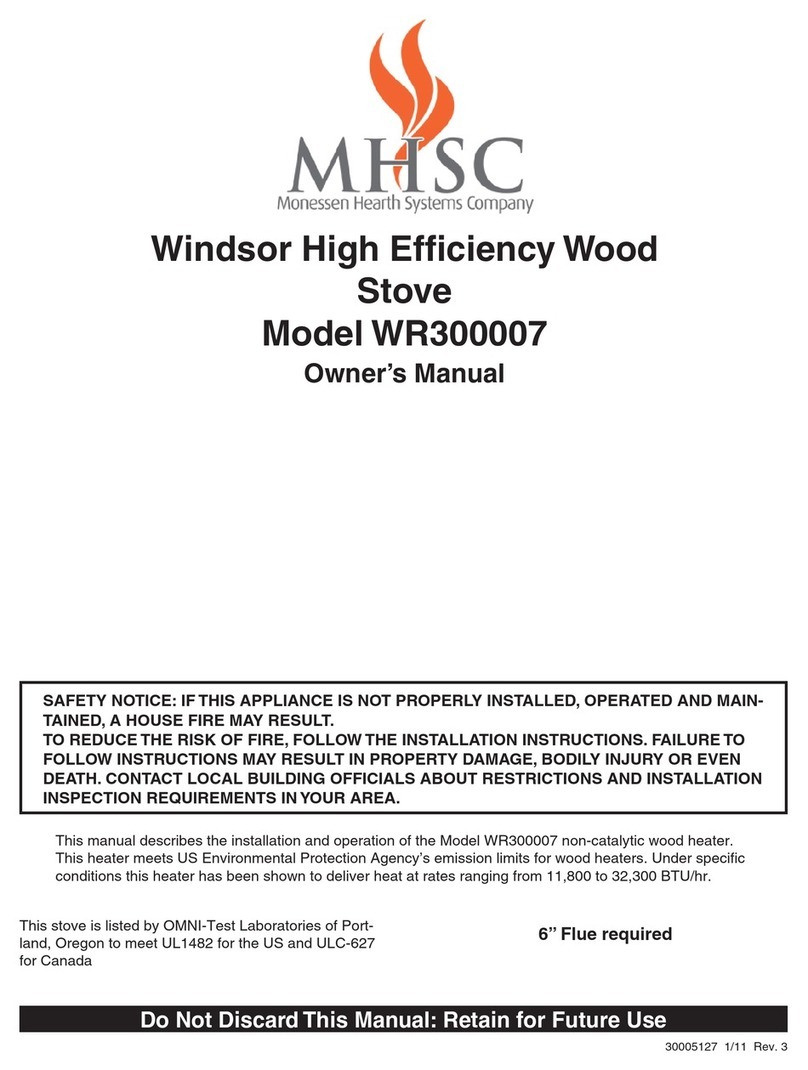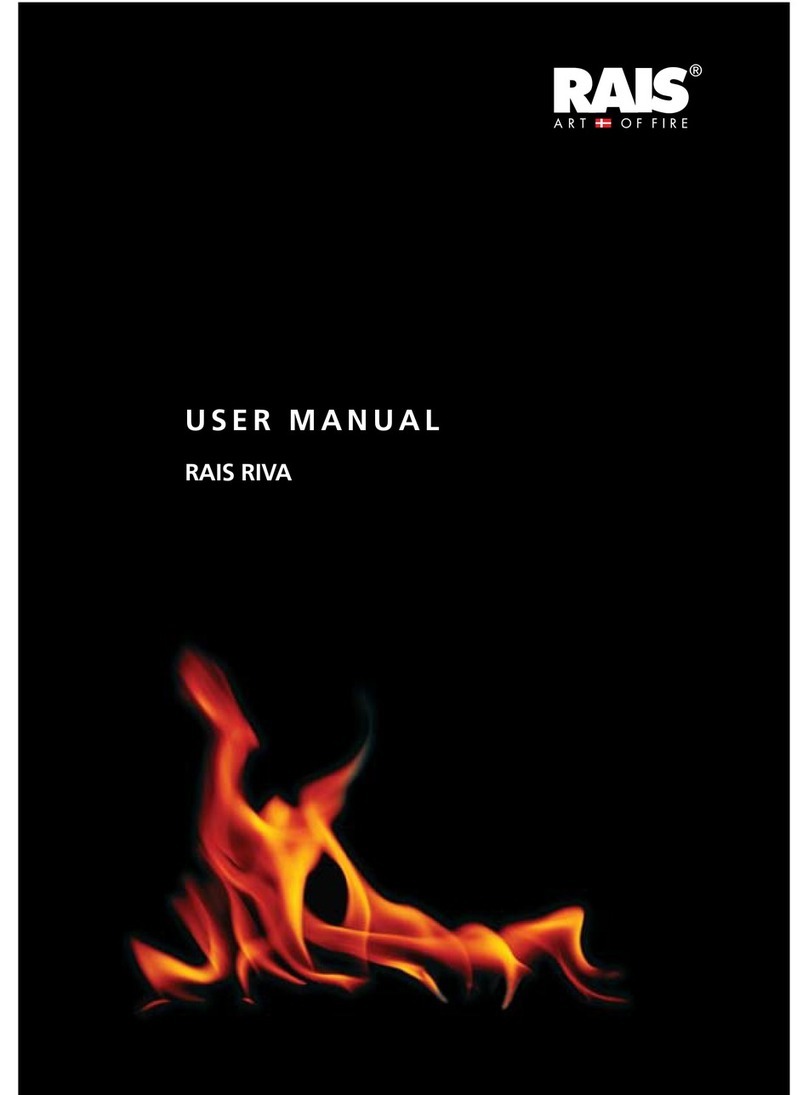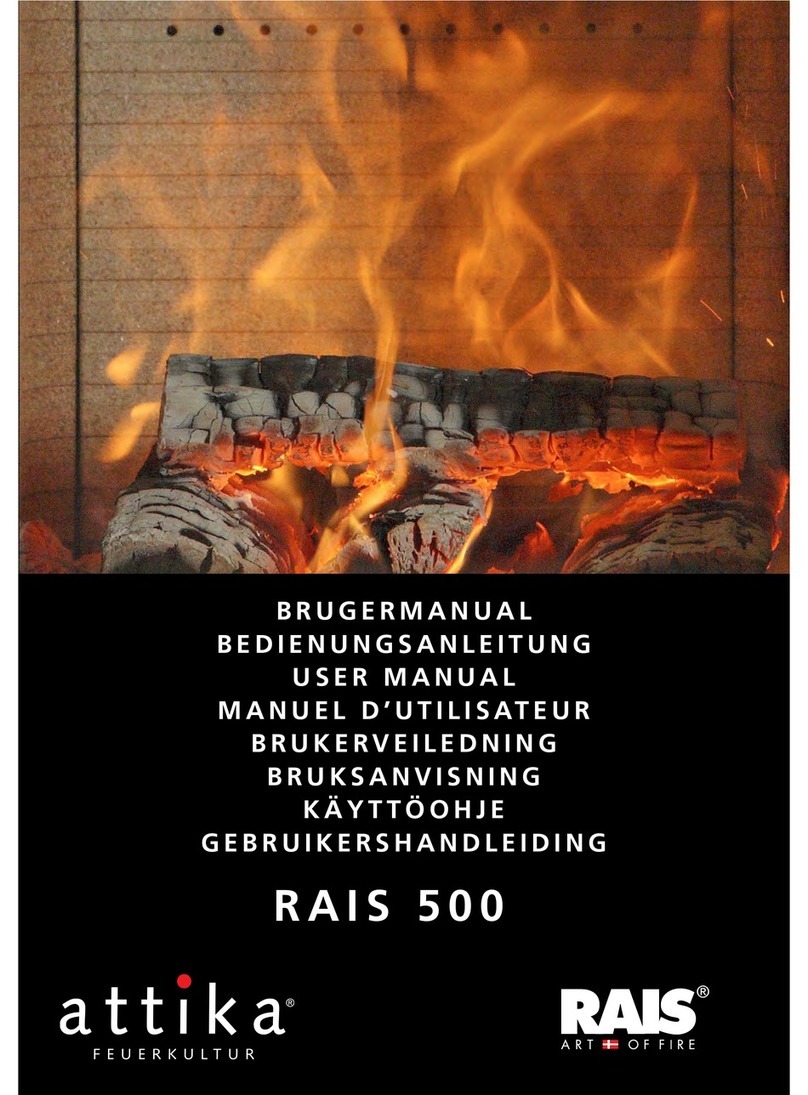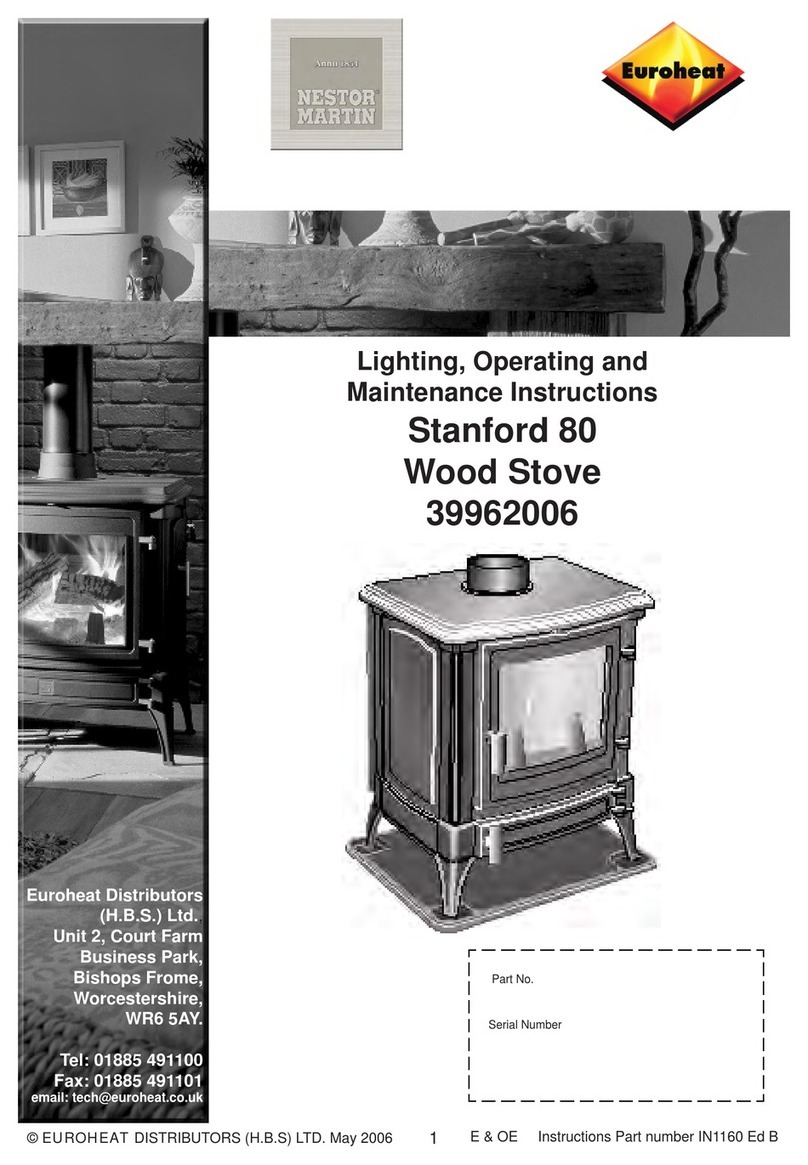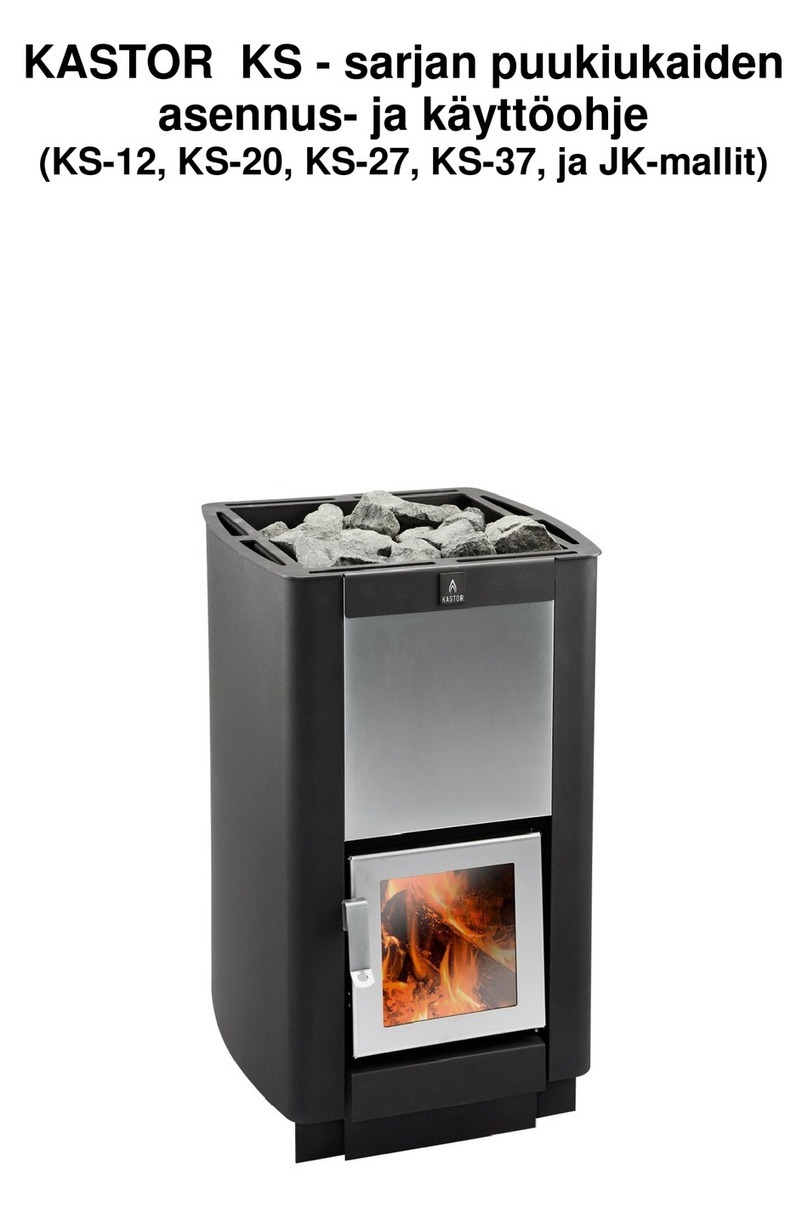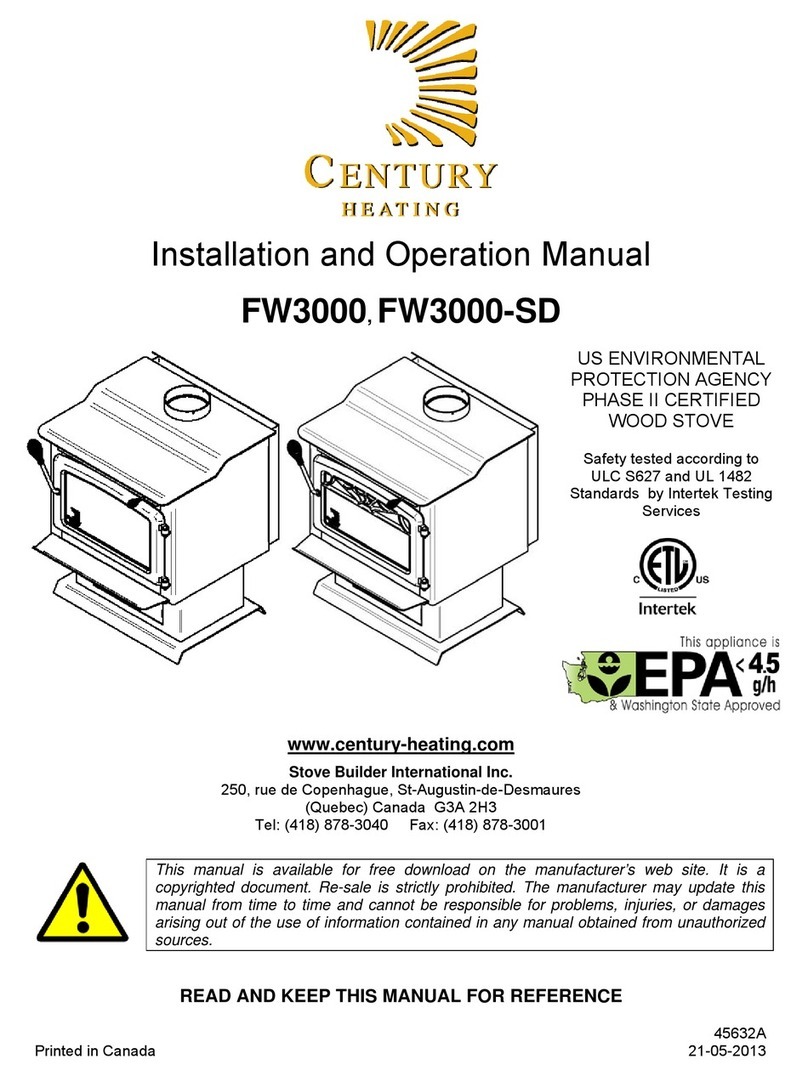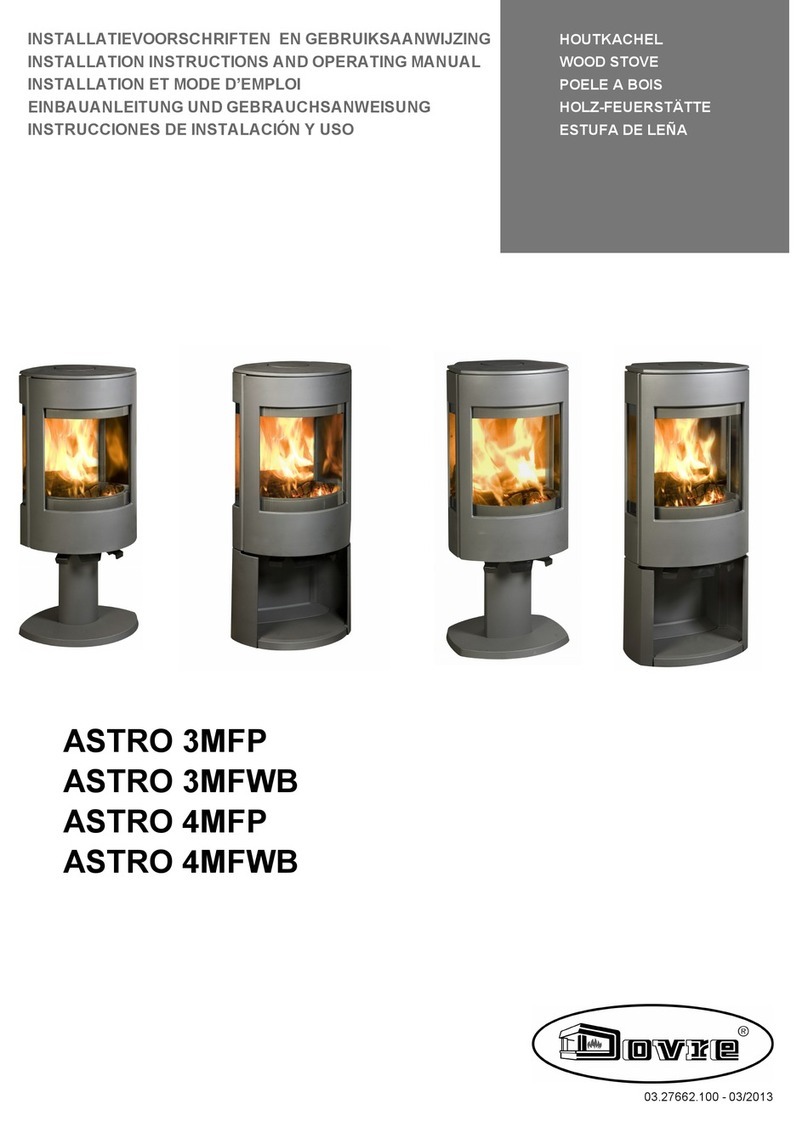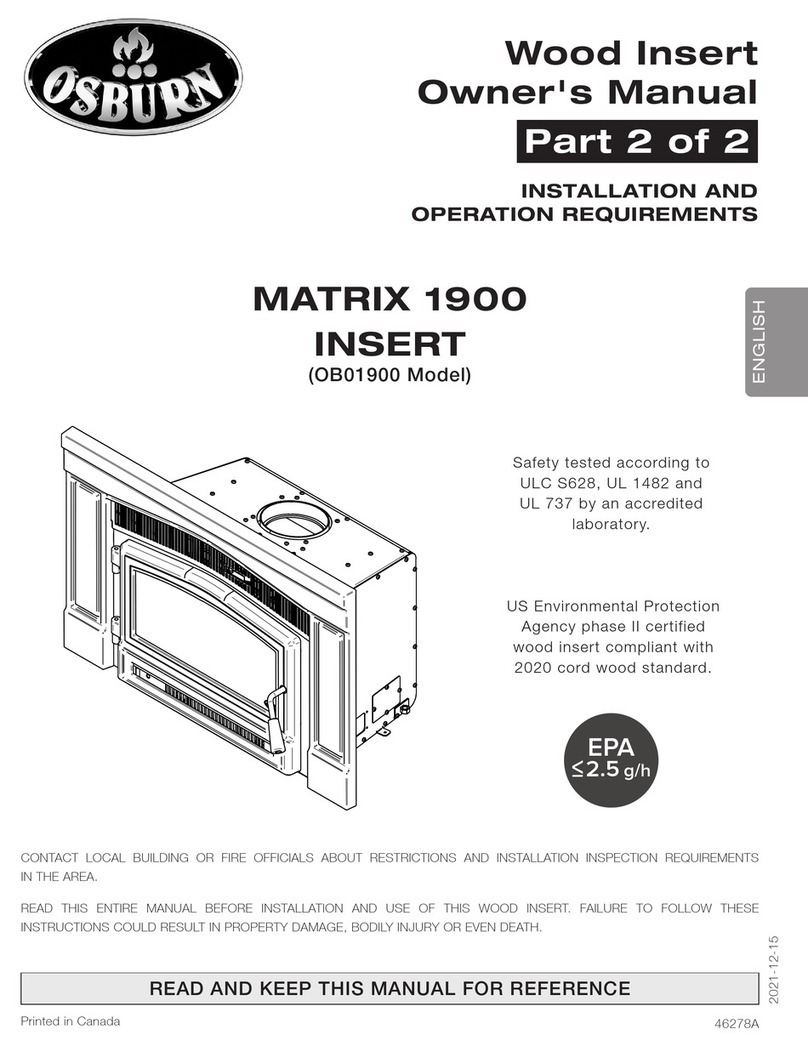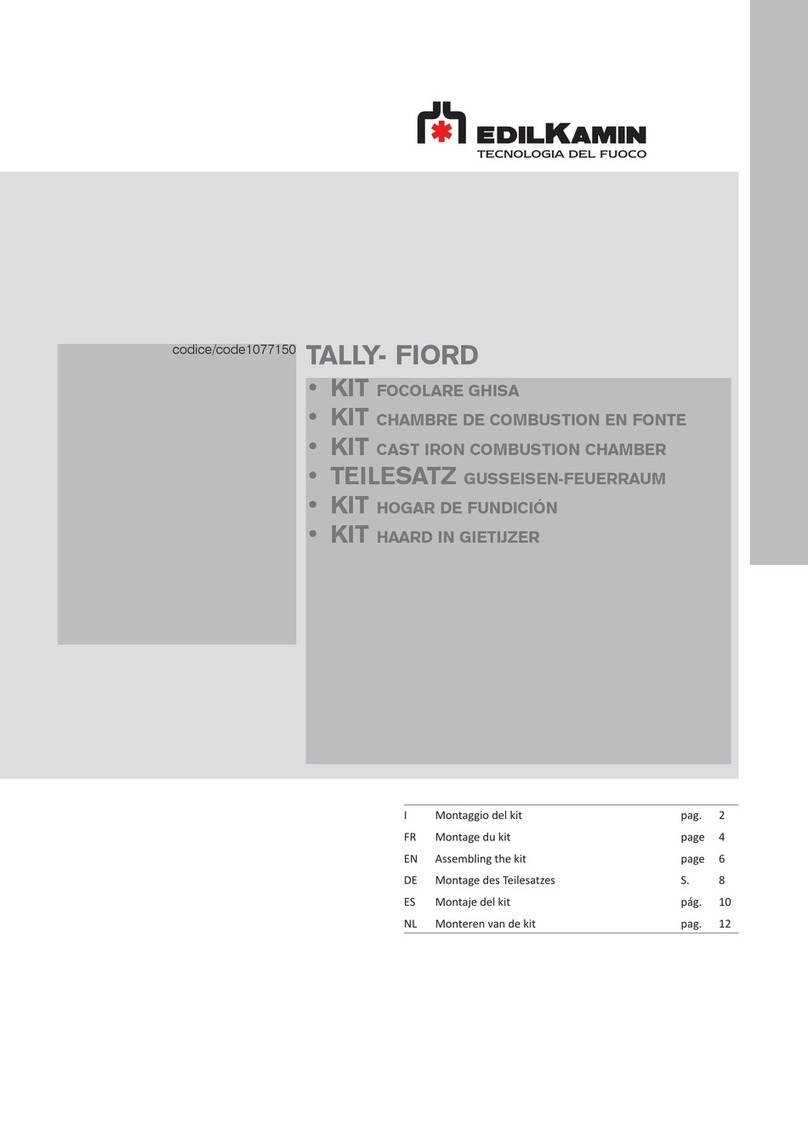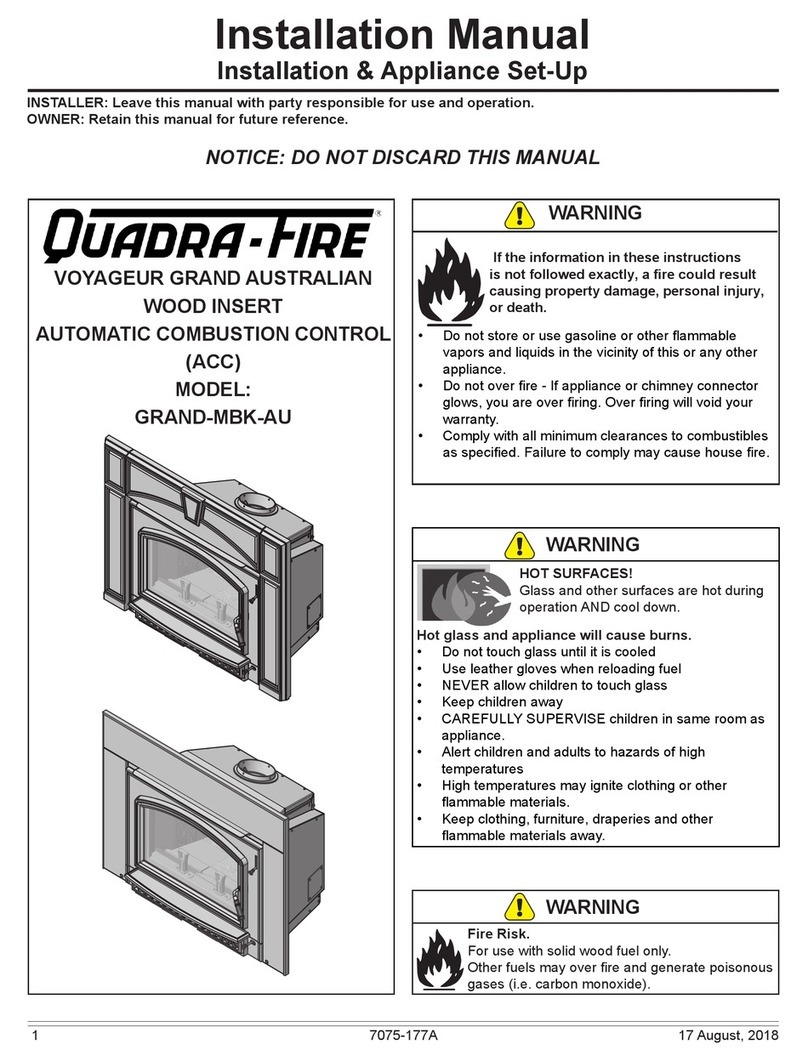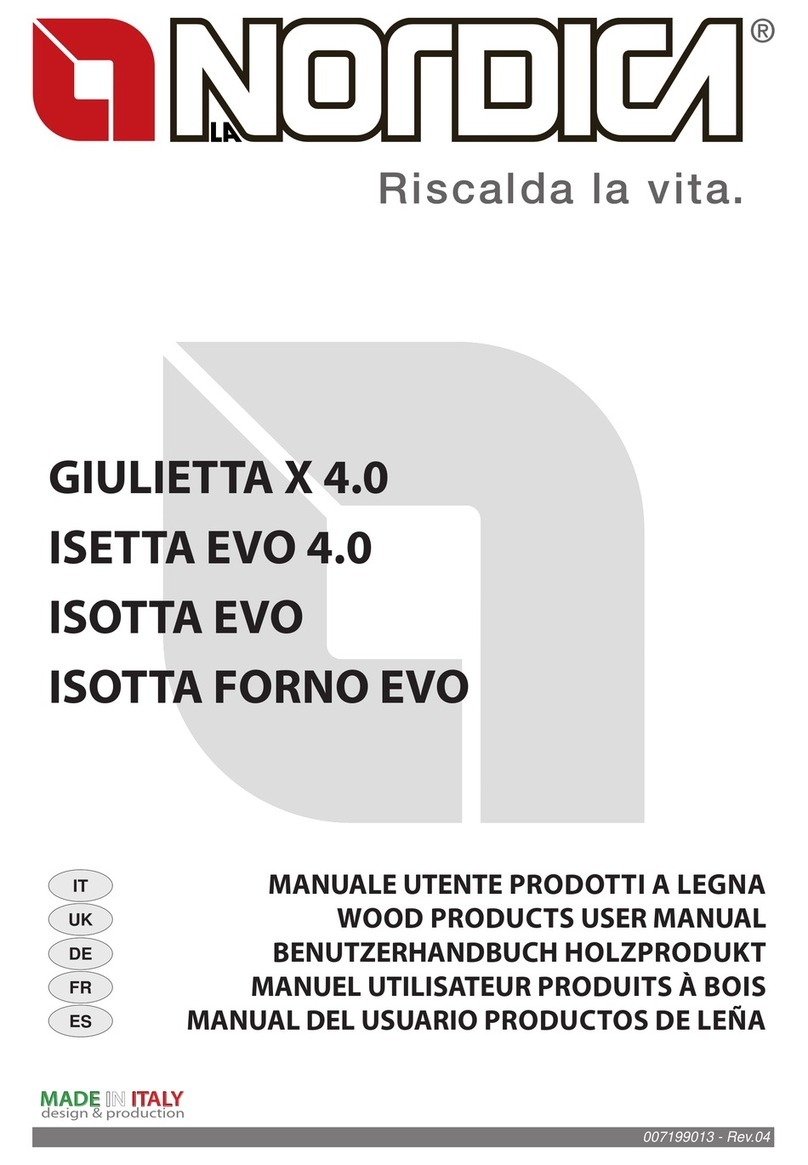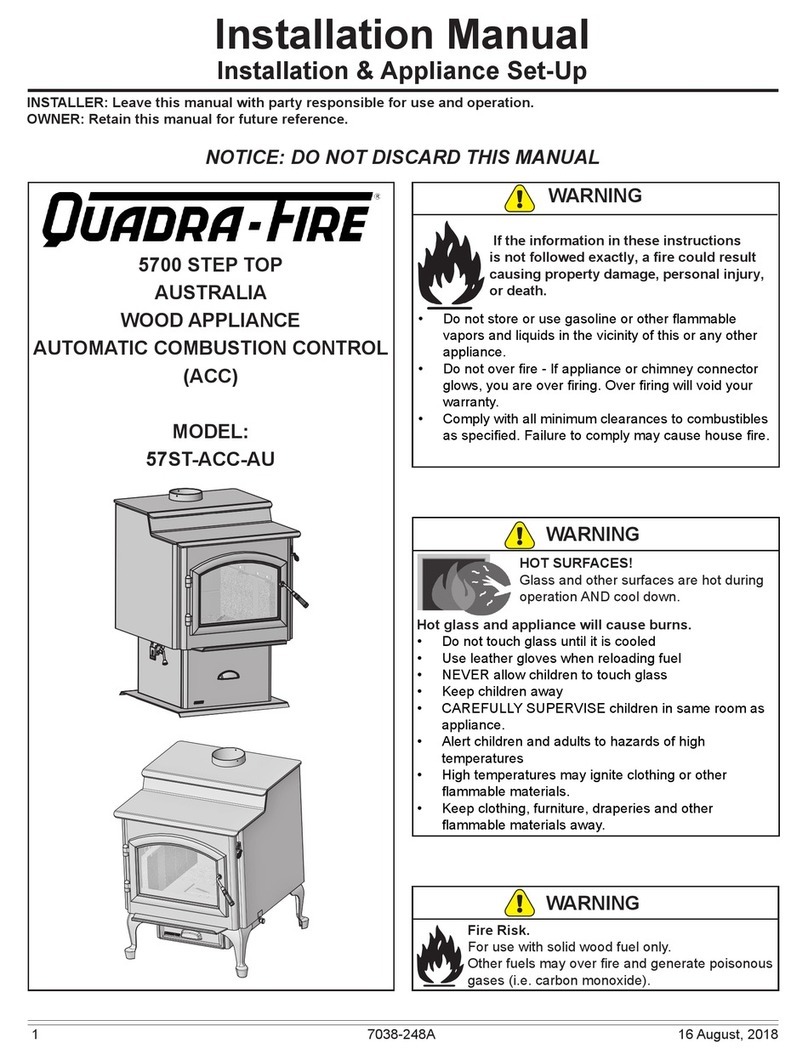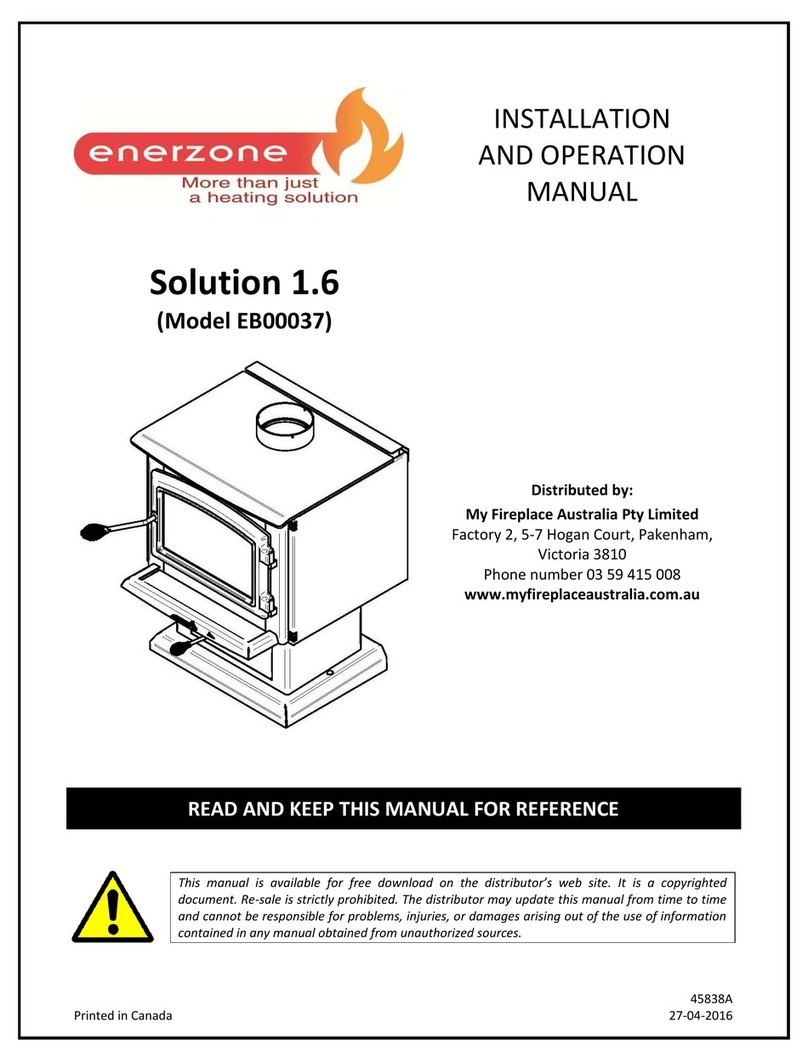MHSC SSW30FTAL User manual

For Residential Installation
6" (152 mm)
Flue Required
Homeowner's Installation & Operation Manual
630001
SSW30 cover
Read this entire manual before you install and use your appliance. If not
properly installed, a house fire may result. To reduce the risk of fire, follow the installation instruc-
tions. Failure to follow instructions may result in property damage, bodily injury, or even death.
Contact local building, fire officials or authorities having jurisdiction about permits, restrictions
and installation inspection requirements in your area.
These units are mobile home approved for U.S. and Canada
C US
63D0001 9/10 Rev. 11

263D0001
SSW30 Series Wood Stove
Congratulations on your choice of a MHSC High Efficiency Wood Stove. With this purchase, you
made a commitment to make the hearth a place of warmth, beauty and comfort in your home.
At MHSC, we share that joy and appreciation of the hearth, and we show it in all our cast iron
stoves and fireplaces.
As you become acquainted with your new stove, you will find the aesthetic appeal of cast iron
is matched only by its superb capacity to absorb and radiate heat.
Also, MHSC products are among the cleanest burning wood stoves and fireplaces available
today. As an owner of a MHSC stove, you are making a strong statement for pollution-free en-
ergy. But clean burning depends on both the manufacturer and the operator. Please read this
manual carefully to understand how to properly operate your stove.
At MHSC, we are equally committed to your satisfaction as a customer and that is why we main-
tain an exclusive network of the finest dealers in the industry. Chosen for their expertise and
dedication to customer service, our dealers are factory-trained and know each MHSC product
in detail. Feel free to contact your Authorized MHSC Dealer anytime you have a question about
your stove or its performance.
We have built your stove with the utmost care. With normal use and proper care, it will provide
you with many years of service.
This manual contains valuable instructions on the installation and operation of your MHSC stove.
You will also find useful information on assembly and maintenance procedures. We urge you
to read the manual thoroughly and to keep it as a reference.
Sincerely,
All of us at MHSC
This manual describes the installation, operation, and maintenance of the MHSC Challenger
wood burning heater. This heater meets the U.S. Environmental Protection Agency’s emission
limits for wood heaters sold on or after July 1, 1990. Under specific test conditions this heater
has been shown to deliver heat at rates ranging from 11,000 to 30,600 Btu/hr.
The stove has been tested and is listed by Canadian Standards Association (CSA). The test
standards are ANSI/UL-1482 for the United States, and ULC S627 for Canada. The Challenger
is listed for burning wood only. Do not burn other fuels. The Challenger is approved for use in
manufactured (mobile) homes in the United States and Canada, only when installed with MHSC
Mobile Home Kit No. SSWMHIK.
Installation or service of this woodburning stove should only be completed by a qualified installer,
preferably NFI or WETT (Canada) certified.
Please read this entire manual before you install and use your new stove. Failure to follow
instructions may result in property damage, bodily injury, or even death.

3
63D0001
SSW30 Series Wood Stove
Accessories .................................................................. 3
Safety Information ........................................................ 4
Installation Information ................................................. 5
Stove Specifications & Dimensions .............................. 6
Stove set-up ................................................................. 7
Installation .................................................................... 7
Clearances ................................................................. 17
Operation .................................................................... 18
Maintenance ............................................................... 19
Replacement parts ..................................................... 22
FAQs........................................................................... 25
Warranty ......................................................................27
Read these instructions carefully before installing or trying to operating this woodburning appliance.
Please leave these instructions with the appliance.
Please retain these instructions for future reference
.
Fuels used in gas, wood-
burning or oil fired appliances, and the products of
combustion of such fuels, contain chemicals known
to the State of California to cause cancer, birth de-
fects and other reproductive harm.
California Health & Safety Code Sec. 25249.6
Ash Pan Door Handle Kit SSW30AHK
Baffle Insulation Kit SSW30BI
Brick Kit SSW30BK
Gasket Kit SSW30GK
Glass Door Handle Kit SSW30DHK
Glass Door Kit SSW30GDK
Legs
Gold SSW30CLGD
Nickel SSW30CLN
Mobile Home Insulation Kit SSWMHIK
Outside Air Termination Kit SSWOATK
Pedestal Ash Pan Door Handle Kit SSW30APHK
Primary Air Module Kit SSW30PAM
Seconday Air Tubes Kit SSW30SAT
Trim
Gold Door Trim SSW30GDTK
Nickel Door Trim SSW30NDTK
Variable Speed Blower BLOTWS
WARNING
!
HOT GLASS WILL
CAUSE BURNS.
DO NOT TOUCH GLASS
UNTIL COOLED.
NEVER ALLOW CHILDREN
TO TOUCH GLASS.
First, contact the MHSC Dealer from whom you purchased
your stove, for parts and service. Have the following information ready:
• Date of purchase
• Serial number (from the back of your stove)
• Model number (from the back of your stove)
• Dealer name and phone
If you still need assistance, contact MHSC technical support (below).
See the last page of this manual for general warranty information. For additional information, contact your
MHSC dealer or MHSC Parts and warranty.
Model and product serial numbers can be found on the certification label of your stove.

463D0001
SSW30 Series Wood Stove
Read all instructions and warnings carefully before starting installation. Failure to
follow these instructions may result in a possible fire hazard and will void the warranty.
MHSC stoves and component parts have been tested to op-
erate safely when installed in accordance with instructions
provided in this manual. Carefully read and understand all
instructions before beginning installation.
If you notice any damage to stove or component parts,
immediately report damage to your MHSC dealer.
Only use MHSC components or the warranty will be voided
and a fire hazard may be created.
MHSC warranty will be voided by and MHSC disclaims any
responsibility for the following actions:
•
•
(except for chase flash-
ings as detailed in MHSC Chimney Top installation
instructions).
• MHSC
•
MHSC
MHSC
Consult local building codes to ensure that you are in
compliance installing the stove.
This stove and chimney system must be vented out-
doors.
1. Check with the building inspector’s office for compliance
with local codes; a permit may be required.
2. This appliance requires a masonry or prefabricated
chimney listed to ULC S629 (Canada) and UL 103HT
(U.S.) sized correctly.
3. A 6" (152 mm) diameter flue is required for proper
performance.
4. Always connect this unit to a chimney and VENT
TO ANOTHER ROOM OR INSIDE A BUILDING.
connect this unit to any duct work to which
another appliance is connected such as a furnace.
connect this unit to a chimney flue serving
another appliance.
The connector pipe and chimney should be inspected
periodically and cleaned if necessary.
8. Remember the clearance distances when you place
furniture or other objects within the area. store
wood, flammable liquids or other combustible materials
too close to the unit.
9. Contact your local municipal or provincial fire authority
for information on how to handle a chimney fire. Have
a clearly understood plan to handle a chimney fire. In
the event of a chimney fire, turn air control to closed
position and
tamper with combustion air control beyond
normal adjustment.
11. If installing in a mobile home:
a. Use mobile home kit.
b. install in sleeping room.
c. The structural integrity of the mobile home floor,
walls and ceiling/roof must be maintained.

5
63D0001
SSW30 Series Wood Stove
Draft is the force, which moves air from the appliance up
through the chimney. The amount of draft in your chimney
depends on the length of the chimney, local geography,
nearby obstructions, and other factors. Too much draft
may cause excessive temperatures in the appliance. An
uncontrolled burn, a glowing red part or chimney connector
indicates excessive draft. Inadequate draft may cause back
puffing into the room and “plugging” of the chimney and/or
cause the appliance to leak smoke into the room through
appliance and chimney connector joints.
Today’s solid fuel appliances are much more efficient than
in the past. The units are designed to give you controlled
combustion, as well as maximum heat transfer, using less
fuel to do so. The design of your new appliance is such that
the exhaust “smoke” is now at lower temperatures than in
the past, therefore requiring proper chimney size to give
adequate draft. If your chimney is too large, the heating
appliance will have a difficult time to raise the “chimney
flue” temperature to give adequate draft, therefore causing
a smoke back up, poor burn, or both.
Should you experience such a problem call in a local
chimney expert.
With the door closed, the rate of burning is regulated by
the amount of air allowed to enter the unit through the air
control. With experience you will be able to set the control
for heat and burning time desired.
Once the required chimney draft is obtained, operate only
with doors closed and open slowly when re-fueling. (This
will reduce or eliminate smoke from entering the room.)
Attempts to achieve higher output rates that exceed heater
design specifications can result in permanent damage to
the heater. The recommended wood load is level with the
top of the firebricks. Overloading may prevent sufficient
air entering the heater to properly fuel the fire.
For optimum heater performance at “low”
burn rate, operate the fan at low speed.
An outside air kit is available from your MHSC dealer.
Optional Blower: 110v 130 CFM Model: BLOTWS
Do not abuse the glass by slamming the door or striking the
glass with a log. Never operate your stove if it has damaged
or broken glass. If you need to replace the glass, use only
replacement glass provided by your MHSC dealer.
• Adjustable wrench
• Flat & Phillips screwdriver
• Drill
• Tape measure
• Safety gloves
• Eye protection
• Appropriate venting components
• Furnace cement

663D0001
SSW30 Series Wood Stove
A
C
D
F
A
B
E
G
630001
SSW30 dims
A
B
E
G
A
B
E
G
A
B
C
D
A 30Z\v" (768 mm) 33C\v" (857 mm) 32C\v" (832 mm) 32C\v" (832 mm) 36Z\v" (921 mm)
B 28Z\v" (718 mm) 28Z\v" (718 mm) 30C\v" (781 mm) 30C\v" (781 mm) 30C\v" (781 mm)
C 19Z\v" (489 mm) 19Z\v" (489 mm) 18Z\x" (470 mm) 19C\v" (502 mm) 19C\v" (502 mm)
D 24Z\v" (616 mm) 24Z\v" (616 mm) 24Z\v" (616 mm) 24Z\v" (616 mm) 24Z\v" (616 mm)
E 26" (660 mm) 26" (660 mm) 25Z\x" (648 mm) 26C\," (670 mm) 26C\," (670 mm)
F n/a 32" (813 mm) n/a n/a 34Z\x" (876 mm)
G 27C\v" (705 mm) 27C\v" (705 mm) 27C\v" (705 mm) 27C\v" (705 mm) 27C\v" (705 mm)
Log Length.................................................................20"
Maximum burn time2.......................................... 10 hours
Average area heated (sq.ft)2 ........................ 2,200 sq. ft.
Range of heat output3............................... 11,000-30,600
Maximum heat output1.......................................... 55,400
EPA emissions rating (g/h, non-catalytic) ........... 2.5 gph
Weight ..................................................................520 lbs
Loading ...................................................................Front
Air Control............................................................ Manual
1. Maximum burn times and heat outputs are based
on laboratory testing using full loads of seasoned
hardwoods, and may vary in individual use depending
on how the stove is operated, type and moisture content
of fuel, and other factors. Maximum burn times are
achieved under different operating conditions than are
maximum heat outputs.
2. These values are based on operation in building
code-conforming homes under typical winter climate
conditions in the U.S. If your home is of nonstandard
construction (e.g. unusually well-insulated, not insulated,
built underground, or if you live in a more severe and
more temperate climate), these figures may not apply.
Since so many variables affect performance, consult
your MHSC Authorized Dealer to determine realistic
expectations for your home.
3. Under specific conditions used during EPA emissions
testing.
Figure 1 -
Stove Dimensions

7
63D0001
SSW30 Series Wood Stove
Before you begin an installation, review your plans to see
that:
• Your stove and chimney connector will be far enough
from combustible material to meet all clearance
requirements.
• The floor protector is large enough and is constructed
properly to meet all requirements.
• You have all necessary permits from local authori-
ties.
Your local building official is the final authority for approv-
ing your installation as safe and determining that it meets
local and state codes.
The metal label permanently attached to the back of every
MHSC stove indicates the stove has been tested to current
standards. The test standards are ANSI/UL-1482 for the
United States and ULCS627 for Canada. Clearance and
installation information also is printed on the label. When
the stove is installed according to the information both on
the label and in this manual, local authorities in most cases
will accept the label as evidence that the installation meets
codes and can be approved.
However, codes vary in different areas. Before starting
the installation, review your plans with the local building
authority. You local dealer can provide any additional in-
formation needed.
For any unresolved installation issues, refer to CSA CAN-
B365 Installation Code for Solid Fuel Burning Appliances
and Equipment. These standards are the basis for many
national codes. They are nationally recognized and are
accepted by most local authorities. Your local dealer
or your local building official may have a copy of these
regulations.
In some modern, super-insulated homes, there is not enough
air for combustion because of insufficient air infiltration into
the building. Such air enters a home through unsealed
cracks and openings. Kitchen or bath exhaust fans can
compete with the stove for available air and compound
the problem.
When poor draft is caused by a low infiltration rate, open-
ing a ground floor window on the windward side of the
house and in the vicinity of the stove will usually alleviate
the problem.
Another solution is to install a permanent outside air supply
to the stove and/or room. In some areas, in fact, bringing
air for combustion from outside the home directly to the air
inlet of the stove is required for new construction.
An outside air supply is not affected by pressure variations
within the house, and improved stove performance often
results. An Outside Air Adaptor Kit for the Challenger is
available from your local MHSC dealer.
For Canada installations, if an outside air adapter
kit is used, the appliance must be secured directly to the
floor of the home structure.
Stove is extremely heavy. You will need
help installing the legs and moving your stove to its final
location.
The fiberboard baffle is secured with two screws
for shipping purposes only. These screws are located
behind the rear tube and may be removed prior to use, if
so desired.
The legs are packed inside the stove with bolts for
assembling legs to the stove. Useful note: If you misplace
the bolts in the leg pack, the bolts used to hold the
shipping bracket to the stove can be used to hold the legs
in place.
Tools required: 7/16" & 9/16" wrench or socket.
1. Remove the foam leg pack from inside your stove. The
pack should contain 4 legs and 8 bolts.
2. To begin the leg installation remove the bolts from the
hold down brackets from the pallet only. This is so
ST1042
stove on pallet
Figure 2
ST1042

863D0001
SSW30 Series Wood Stove
you will be able to move the stove to the edge of the
pallet and install the legs one at a time. (9/16" wrench
or socket.) Figure 2
3. Slide the stove so that a rear corner of the stove is
extended past the edge of the pallet just enough to
install rear leg. Figure 3
4. Remove both bolts from the rear leg location of the hold
down bracket and one of the bolts from the front leg
location of the same hold down bracket. (7/16" wrench
or socket.)
Figure 3
ST1043
turn stove
ST1043
Figure 4
ST1044
hold down bracket
Hold Down Bracket
FP1044
5. Swing hold down bracket out from stove just far enough
to install rear leg. Figure 4
6. Use the bolts provided to install the rear leg. (7/16"
wrench or socket.) . Figure 5
7. With rear leg installed, pivot the stove so the hold down
bracket is off the pallet. The stove should be resting
on the installed leg on the floor, one support bracket
on the pallet and the partially loosened support bracket
hanging free. Have someone steady the stove to avoid
tipping.
8. Remove the remaining bolt from the hold down bracket
and install front leg. Figures 6 & 7
ST1045
attach leg
Figure 5
ST1045
ST1046
attach front leg
Figure 6
ST1046
ST1047
2 legs on
Figure 7
ST1047

9
63D0001
SSW30 Series Wood Stove
9 Pivot the stove or twist the pallet so the rear corner
of the remaining support bracket is extended over the
pallet just far enough to install the rear leg.
10. Remove both of the bolts from the top rear section of
the hold down bracket and one of the bolts from the
top front section of the hold down bracket.
11. Pivot the hold down bracket out of the way just far
enough to install the other rear leg.
12. Pivot the stove or slide the pallet so that the three
installed legs are on the floor and the stove is
completely off the pallet.
13. Remove the final remaining bolt from the hold down
bracket and install the final leg.
1. Check that all brick and tubes are in place.
2. Select the proper location for the stove. These
appliances must not be installed any closer than the
minimum clearance to combustible materials shown on
Page 9 of this manual. The stove must be installed on
a non-combustible surface as shown on Page 9 of this
manual.
3. Remove packing material and packing labels from
glass.
4. If noncombustible materials have been installed on the
walls, obtain the minimum clearances from either the
manufacturer of these materials or the local building
inspectors office.
5. Install the stovepipe INSIDE the flue collar on the top
of the stove between the stove and chimney.
6. use a grate to elevate the fire.
1. Make sure your chimney and chimney connector meets
safety codes. Check with authorities having jurisdiction
in your area.
2. All pipe sections must be connected with the male end
(crimped end) toward the stove.
3. Fasten the stove pipe to the flue collar by the use of three
sheet metal screws. Do the same at each additional joint
to make the entire installation rigid.
4. Maintain the required diameter flue for the entire
installation.
5. If you are connecting the stove to an old masonry flue,
be sure to have it inspected for cracks and general
condition. Resizing with a stainless steel liner may be
required.
6. It is recommended that no more than two 90 degree
bends be used in the stovepipe installation. More than
two 90 degree bends may decrease the amount of draw
and possible cause smoke spillage.
7. A damper is not required in this installation. Remove
any damper plate in the chimney or secure in the
position.
8. Single wall flue pipe assemblies must not exceed 10
feet (3 meters) in overall length.
Maintaining a clean chimney is important. Chimneys should
be inspected regularly for creosote buildup. A straight
chimney is easier to clean than one with 45 or 90 degree
bends. A bend requires the pipe to be removed for cleaning.
The stove baffle must be removed when cleaning the
chimney. Chimney sweepings will build up on top of baffle
causing a blocked flue and/or a fire hazard.
Most factory made “Class A” steel chimneys have a layer
of insulation around the inner flue. This insulation keeps
the smoke warm and protects the surrounding structure
from the high flue temperatures. Because the insulation is
less dense than masonry, the inner steel liner warms up
more quickly than masonry chimney; this makes the steel
chimney support a good draft more quickly than masonry
does.
Because the chimney’s function is to keep the smoke
warm, it is best to locate it inside the house. This location
uses the house as insulation for the flue and allows some
radiant heat release form the flue into the home. Since an
interior chimney doesn’t continuously lose its heat to the
outdoors, less heat from the stove is required to get it warm
and keep it warm.
The flue size for a controlled-combustion appliance should
be based on the cross-sectional volume of the stove flue
outlet. In this case, more is definitely not better. Hot gases
lose heat through expansion; if a stove with a six-inch flue
collar (28 square inch area) is vented into a 10" x 10" flue,
the gases will expand to over three times their original
volume. As gases cool with expansion, draft strength
decreases. If the oversized flue is also outside the house,
the heat it absorbs will be conducted to the outdoor air and
the flue will remain relatively cool.
It is common for a masonry flue to be oversized for the
stove. Such a chimney can take quite a while to warm up,
and the stove performance will likely be disappointing. The
best solution to an oversize flue problem is the installation
of an insulated steel chimney liner of the same diameter
as the appliance flue outlet. The liner keeps the exhaust
gas warm and the result is a stronger draft. An uninsulated
liner is a second choice—although the liner will keep the

10 63D0001
SSW30 Series Wood Stove
exhaust restricted to its original volume, the air around the
liner will require time and heat energy to warm up.
Check your local codes. You may be required to install a
flue liner in any oversize masonry flue.
Although masonry is the traditional material used for
chimney construction, it can have distinct performance
disadvantages when used to vent a controlled combustion
wood stove. Masonry forms an effective “heat sink”—that
is, it absorbs and holds heat for long periods of time.
The large mass however, may take a long time to become
hot enough to sustain a strong draft. The larger the
chimney (in total mass) the longer it will take to warm up.
Cold masonry will actually cool exhaust gases enough
to diminish draft strength. This problem is worse if the
chimney is located outside the home or if the chimney
flue has a cross-sectional volume much larger than the
stove outlet.
Every bend in the flue will act as a brake on the exhaust
as it flows from the firebox to the chimney cap. The ideal
pipe and chimney layout is straight up from the stove
through completely straight chimney. Use this layout if at
all possible, as it will promote optimum stove performance
and simplify maintenance.
If the stovepipe must elbow to enter a chimney, locate
the elbow about midway between the stovetop and the
chimney thimble. This configuration lets the smoke speed
up before it must turn, keeps some pipe in the room for
heat transfer, and allows long-term flexibility for installing
a different appliance without relocating the thimble. There
should be no more than eight feet of single-wall stove pipe
between the stove and a chimney. Longer runs can cool
the smoke enough to cause draft and creosote problems.
Use double-wall stove pipe for longer runs.
Your stove requires a dedicated flue. Do not connect the
stove to a flue used by any other appliance. Chimney
draft is a natural form of energy and follows the path of
least resistance. If the stove is vented to a flue that also
serves open replace or another appliance, the draft will
also pull air through those avenues.
The additional airflow will lower the flue temperatures,
reduce draft strength and promote creosote
development; overall stove performance will suffer.
The effect is similar to that of a vacuum cleaner with a
hole in the hose. In some extreme instances, the other
appliances can even impose a negative draft and result
in a dangerous draft reversal.
Contact your local building authority for approved methods
of installation
1. This appliance requires a masonry or pre-manufactured
chimney listed to ULCS629 (Canada) and UL 103 HT
(USA) sized correctly.
2. If a masonry chimney is used it is advisable to have your
chimney inspected for cracks and check the general
condition before you install your unit. Re-lining may
be required to reduce flue diameter to the appropriate
functional size.
3. The chimney should extend at least 3' (914 mm) above
the highest point where it passes through the roof, and
at least 2' (610 mm) higher than any portion of a building
within 10' (3 m). Figure 8
4. The chimney connector shall not pass through an attic,
roof space, closet, concealed space, floor, ceiling, wall
or any partition of combustible construction.
5. The minimum overall height of your chimney should be
15' (5 m) from the floor.
6. Do not use makeshift compromises during
installation.
0 to 10’
2’ Min.
3’ Min.
0 to 10’
2’ Min.
3’ Min.
ST1012
2 3 10 rule
Reference Point ST1012
Figure 8 -
The 2'-3'-10' Chimney Rule
At the very least, inspect the chimney connector and
chimney at least once every two months during the heating
season to determine if a buildup of creosote or soot has
occurred. If a significant layer of creosote has accumulated
(1/8" (3 mm) or more], or if soot has accumulated, either
should be removed to reduce the risk of a chimney fire.
Failure to keep the chimney and connector system clean
can result in a serious chimney fire.
The conditions for a chimney fire develop as follows: When
wood is burned slowly, it produces tar and other organic
vapors which combine with expelled moisture to form
creosote. The creosote vapors condense in the relatively

11
63D0001
SSW30 Series Wood Stove
cool chimney flue of a slow burning fire. As a result
creosote residue accumulates on the flue lining. Creosote
is a flammable and, when ignited, make an extremely hot
fire within the flue system which can damage the chimney
and overheat adjacent combustible material.
To reduce the amount of creosote that may form, remember
to provide adequate air for combustion and to strive for
small, intense fires rather than large smoldering ones.
You can never be too safe. Contact your local fire authority
for information on what to do in the event of a chimney
fire, and have a clearly understood plan on how to handle
one.
Chimney connector is the double-wall or single-wall pipe
that connects the stove to the chimney. The chimney is a
masonry or prefabricated structure that encloses the flue.
Chimney connectors are used only to make the connection
from the stove to the chimney.
Double-wall chimney connectors must be tested and
listed for use with solid-fuel burning appliances. Single-
wall chimney connectors should be made of 24 gauge or
heavier steel, and should be 6” (150 mm) in diameter. Do
not use galvanized connector; it cannot withstand the high
temperatures that can be reached by smoke and gases,
and may release toxic fumes under high heat.
If possible, do not pass the chimney connector through a
combustible wall or ceiling. If passage through a combus-
tible wall is unavoidable, refer to the section following on
Wall Pass-Throughs. Do not pass the chimney connector
through an attic, a closet, or any similar concealed space.
The whole connector should be exposed and accessible
for inspection and cleaning.
In horizontal runs of single-wall chimney connector without
protective shields, maintain a clearance of at least 26” (660
mm) from the ceiling. For information on reduced clear-
ances using shields on single-wall chimney connector or
using double-wall connectors, see the clearance chart on
Page 15.
Keep the horizontal run of chimney connector as short
and direct as possible, with no more than two 90° turns.
Slope horizontal runs of connector upward 1/4” per foot
(20 mm per m) going from the stove toward the chimney.
The recommended maximum length of a horizontal run is
3’ (914 mm). The recommended total length of chimney
connector is 8’ (2.4 m).
In cathedral ceiling installations, extend the prefabricated
chimney down to within 8’ (2.4 m) of the stove.
The listing for the Challenger for the U.S. and Canada
includes use of double-wall chimney connectors that have
been tested and listed for use with solid-fuel burning ap-
pliances by a recognized testing laboratory.
Information on assembling and installing double-wall con-
nector is provided by the manufacturer of the double-wall
pipe. Follow the manufacturer’s instructions exactly as
you assemble the connector and attach it to the stove
and chimney. Using connectors and chimneys from the
same manufacturer makes the assembly and installation
straightforward.
• Beginning at the flue collar of the stove, assemble
the chimney connector. Insert
the first crimped end into the
stove’s flue collar, and keep
each crimped end pointing to-
ward the stove. Using the holes
in the flue collar as guides, drill
1/8” (3 mm) holes in the bottom
of the first section of chimney
connector and secure it to the
flue collar with three #10 x 1/2”
sheet metal screws.
• Secure each joint between
sections of chimney connector,
including telescoping joints,
with at least three sheet metal
screws. The pre-drilled holes
in the top of each section of chimney connector serve as
guides when you drill 1/8” (3 mm) holes in the bottom of
the next section.
• Secure the chimney connector to the chimney. Instruc-
tions for various installations follow.
• Be sure the installed stove and chimney connector are
correct distances from nearby combustible material.
Special slip pipes and thimble sleeves that form
telescoping joints between sections of chimney connector
are available to simplify installations. They often eliminate
the need to cut individual connector sections. Consult your
local dealer about these special pieces.
For prefabricated chimneys, follow the installation instruc-
tions of the chimney maker exactly as you install the chim-
ney. The maker of the chimney will supply the accessories
to support the chimney, either from the roof of the house,
ST242
Chimney connector
12/13/99 djt
Figure 9 -
Chimney Connector

12 63D0001
SSW30 Series Wood Stove
at the ceiling of the room where the stove is installed, or
from an exterior wall.
Special adapters are available from your local dealer to
make the connection between the prefabricated chimney
and the chimney connector. The top of such adapters
attaches directly to the chimney or to the chimney’s ceil-
ing support package, while the bottom of the adaptor is
screwed to the chimney connector.
These adapters are designed so the top end will fit outside
the inner wall of the chimney, and the bottom end will fit
inside the first section of chimney connector. When as-
sembled in this way, any soot or creosote falling from the
inner walls of the chimney will stay inside the chimney
connector.
For masonry chimneys, both freestanding and fireplace
chimneys may be used for installation of your stove.
ST243
thinble connection
12/13/99 djt
Thimble Sleeve
Chimney
Connector
Flue
Keep
sleeve
end
flush
with flue
tile
ST243
Figure 10 -
Chimney Connector Thimble Sleeve
If the chimney connector must pass through a combustible
wall to reach the chimney, follow the recommendations in
the Wall Pass-through section that follows.
The opening through the chimney wall to the flue (the
“breach”) must be lined with either a ceramic or metal cylin-
der, called the “thimble”, which is cemented firmly in place.
The fit must be snug and the joint between the thimble and
the chimney wall must be cemented. Figure 11
A special piece called the “thimble sleeve,” slightly smaller
in diameter than standard connector and most thimbles,
will facilitate the removal of the chimney connector system
for inspection and cleaning. Thimble sleeves should be
available from your local dealer. Figure 10
To install a thimble sleeve, slide it into the breach until it is
flush with the inner flue wall. Do not extend it into the actual
flue passage, as this could interfere with the draft.
The thimble sleeve should protrude 1-2” (25-50 mm) into
the room. Use furnace cement and thin gasketing to seal
the sleeve in place in the thimble. Secure the chimney
connector to the outer end of the sleeve with sheet metal
screws.
ST1094
freestanding
installation
Chimney
Elbow
Slip Pipe
Standard
Chimney
Connector
Flue Collar
Flue
Flue
Liner
Thimble
ST1094
Figure 11 -
Freestanding Installation Chimney Connection
Without a thimble, a suitable length of chimney connector
can be extended through the breach to the inner face of
the flue liner, and cemented securely in place. Additional
pieces of connector are then attached with sheet metal
screws.
The Challenger may be connected to a chimney above a
fireplace opening also. In such installations, the stove is
positioned on the hearth in front of the fireplace and the
chimney connector rises from the stove top and then angles
ninety degrees back into the chimney. Figure 12
The chimney liner should extend to the point at which the
chimney connector enters the chimney.
If the chimney connector from your installation enters the
chimney above a fireplace, follow all the guidelines men-
tioned above for freestanding installations. In addition, give
special consideration to the following points:
• Check the clearance between the stove and the chimney
connector, and any combustible trim or the mantel. Use
the necessary combination of mantel, trim, and connec-
tor heat shields to achieve the required clearances.
• Check the clearance between the chimney connector
and the ceiling. If no heat shields are used, the clear-
ance should be at least 26” (660 mm). To find out how
much this clearance may be reduced with heat shields,
see the clearance chart on Page 17.

13
63D0001
SSW30 Series Wood Stove
ST1095
chimney connector above
fireplace
Chimney Connector
Shields
* Check These
Clearances
*
*
Mantel
Seal the
Damper
ST1095
Figure 12 -
Chimney Connection Above a Fireplace
• The fireplace damper must be sealed to prevent room
air from escaping up the flue. However, it must be
possible to re-open the damper to inspect or clean the
chimney.
If your fireplace height is at least 25” (635 mm), you may
install an Challenger with standard legs through the fireplace
opening using a “positive connection” kit available from
your local dealer. These positive connection kits ensure
a tight fit between the stove flue collar and the chimney
flue. Figure 13. Fireplace installations, whether connected
to the flue above or through the fireplace opening, have
special clearance requirements to adjacent trim and the
mantel. You’ll find the required clearances for theChallenger
fireplace installations on Page 17.
Floor protection requirements also apply to fireplace instal-
lations. Floor protection information is on Page 14.
Whenever possible, design your installation so the connec-
tor does not pass through a combustible wall. If you are
considering a wall pass-through in your installation, check
with your building inspector before you begin. Also, check
with the chimney connector manufacturer for any specific
requirements.
ST1096
chimney thru fireplace
Flexible Connector
Mantel Shield
Fireplace Adaptor Kit
ST1096
Figure 13 -
Chimney Connector Through a Fireplace
Accessories are available for use as wall pass-throughs.
If using one of these, make sure it has been tested and
listed for use as a wall pass-through.
the National Fire Protection As-
sociation (NFPA) has established guidelines for passing
chimney connectors through combustible walls. Many
building code inspectors follow these guidelines when ap-
proving installations.
Figure 14 shows one NFPA-recommended method. All
combustible material in the wall is cut away from the
single-wall connector to provide the required 12” (305 mm)
clearance. Any material used to close up the opening must
be noncombustible.
Three other methods are also recommended by NFPA:
• Using a section of double-wall chimney with a 9” (230
mm) clearance to combustibles.
• Placing a section of chimney connector inside a ventilated
thimble, which in turn is separated from combustibles
by 6” (150 mm) of fiberglass insulating material.
• Placing a section of chimney connector inside a section
of 9” (230 mm) diameter, solid-insulated, factory-built
chimney, with 2” (50 mm) of air space between the
chimney section and combustibles.

14 63D0001
SSW30 Series Wood Stove
The Canadian Standards Association has es-
tablished installation guidelines. The following illustration
shows one method, in which all combustible material in the
wall is cut away to provide the required
18” (457 mm) clear-
ance for the connector. The resulting space must remain
empty. A flush-mounted sheet metal cover may be used
on one side only. If covers must be used on both sides,
each cover must be mounted on noncombustible spacers
at least 1” (25 mm) clear of the wall. Figure 15
Your local dealer or your local building inspector can
provide details for other approved methods of passing
a chimney connector through a combustible wall in your
area. In Canada, this type of installation must conform to
CAN/CSA-B365, Installation Code for Solid Fuel Burning
Appliances and Equipment.
Do not vent your Challenger into a factory-built
(zero-clearance) fireplace. These appliances and their
chimneys are specifically designed as a unit for use as
fireplaces. It may void the listing or be hazardous to adapt
them for any other use.
T
ST1096
Brick pass thru
Wall Stud
Chimney
Connector
Floor
Protection
12” of
Noncombustible
Material
ST1097
Figure 14 -
A Brick Pass thru - Approved In the United States
ST1150
hollow wall pass thru
Figure 15 -
Hollow Wall Pass-through
18" (457 mm)
Empty Space all Around
the Chimney Connector
ST1050
Sheet Metal Cover
(this side only)
A tremendous amount of heat radiates from the bottom plate
of your stove. The floor area directly under and around the
stove will require protection from radiant heat as well as from
stray sparks or embers that may escape the firebox.
Spark, ember and thermal protection must be provided by
a floor protector constructed with noncombustible material
as specified.
Special protection for the floor beneath the stove must be
provided. Use an approved 1” (25 mm) noncombustible
hearth pad with K = 0.84 BTU/in ft2 hr °F or an equivalent
material with an R-value of at least 1.19. (Refer to “How
to Determine if Alternate Floor Protection Materials are
Acceptable” section) The floor protector may be covered
with a decorative noncombustible material if desired. Do
not obstruct the space under the heater.
Protection requirements vary somewhat between the
United States and Canada as follows:
U.S. Installations: The floor protector is required under the
stove and must extend at least 16” from the front of the
stove, and at least 8” from the sides and rear. Figure 16
In Canada: a noncombustible floor protector is required
under the heater also. The floor protector must extend 18”
(457 mm) from the front of the stove, and at least 8” (203
mm) from the sides and rear. Figure 16
All floor protection must be noncombustible (i.e. metals,
brick, stone, mineral fiber boards, etc.). Any organic materi-
als (i.e. plastics, wood paper products, etc.) are combus-
tible and must not be used. The floor protection specified
includes some form of thermal designation such as R-value
(thermal resistance) or k-factor (thermal conductivity).
1. Convert specifications to R-value:
i. R-value given - no conversion needed.
ii. k-factor is given with a required thickness (T) in
inches:
iii. K-factor is given with a required thickness (T) in
inches:
R = x T
1
k
R = x T
1
K x 12

15
63D0001
SSW30 Series Wood Stove
iv. r-factor is given with a required thickness (T) in
inches: R = r x T
2. Determine the R-value of the proposed alternate floor
protector:
i. Use the formula in Step 1 to convert values not ex-
pressed as R.
ii. For multiple layers, add R-values of each layer to
determine overall R-value.
3. If the overall R-value of the system is greater than the
R-value of the specified floor protector, the alternate is
acceptable.
The specified floor protector should be 3/4-inch
thick material with k-factor of 0.84. The proposed alternate
is 4” brick with an r-factor of 0.2 over 1/8” mineral board
with a k-factor of 0.29
Step a: Use formula above to convert specification to R-
value:
Step b: Calculate R of proposed system.
4” brick of r = 0.2, therefore:
Rbrick = 0.2 x 4 = 0.8
1/8” mineral board of k = 0.29, therefore
Rmineralboard = x 0.125 = 0.431
Rtotal = Rbrick + Rmineralboard = 0.8 + 0.431 = 1.231
Step c: Compare proposed system Rtotal of 1.231 to
specified R of 1.19. Since proposed system Rtotal is
greater than required, the system is acceptable.
Definitions
r = =
(ft2)(hr)(°F)
(Btu)(in)
1
k
(Btu)(ft)
(ft2)(hr)(°F)
K =
k = = K x 12
(Btu)(in)
(ft2)(hr)(°F)
R = (ft2)(hr)(°F)
Btu
Do not assume your fireplace hearth is completely non-
combustible.
Many fireplace hearths do not satisfy the “completely non-
combustible” requirement because the brick or concrete in
front of the fireplace opening is supported by heavy wood
framing as in Figure 17. Because heat passes through brick
or concrete readily, it can easily pass through to the wood.
As a result, such fireplace hearths can be a fire hazard and
are considered a combustible floor.
ST1098
floor install
Wood framing
requires protection
from radiant heat
ST1098
Figure 17 -
Supporting timbers under fireplace hearth
are considered to be combustible
Keep in mind that many raised hearths will extend less than
the required clearance from the front of the heater when
it is installed. In such cases, sufficient floor protection as
described above must be added in front of the hearth to
satisfy the minimum floor protector requirement from the
front of the stove: 18” (460 mm) from the front in Canada.
Fireplace hearths must also offer the required protection
of 8” (203 mm) on either side.
Optional 3” (76 mm) short legs may be used only on such
hearths that meet the width and depth requirements out-
lined previously under “floor protection.”
Hearth rugs do not satisfy the requirements for floor pro-
tection.
Fireplace installations also have special clearance require-
ments to the side walls, side decorative trim, and fireplace
mantle. Refer to the information on fireplace and mantel
trim shields in this section.
R = x T = x 0.5 = 0.59
1
k
1
0.84
1
0.29
Figure 16 -
Installation on a Combustible Floor
E
E
D
C
D D
ST1051
floor protection
A
B
ST1051
US Canada
A. 41” 41” (1016 mm)
B. 45” 47” (1194 mm)
C. 16” 18” (457 mm)
D. 8” 8” (203 mm)
E. 2” 2” (51 mm

16 63D0001
SSW30 Series Wood Stove
Both a stove and its chimney connector radiate heat in all directions when operating, and danger-
ous overheating of nearby combustible materials can occur if they are too close to the heat. A safe
installation requires that adequate clearance be maintained between the hot stove and its connector
and nearby combustibles.
Clearance is the distance between either your stove (measured from the back edge of the stove’s top
plate) or chimney connector, and nearby walls, floors, the ceiling, and any other fixed combustible
surface. Your stove has special clearance requirements that have been established after careful
research and testing to UL and ULC standards. These clearance requirements must be strictly
observed.
In addition, furnishings and other combustible materials must be kept away from the stove as well.
In general, a distance of 48” (1220 mm) must be maintained between the stove and moveable com-
bustible items such as drying clothes, furniture, newspapers, firewood, etc. Keeping those clearance
areas empty assures that nearby surfaces and objects will not overheat.

17
63D0001
SSW30 Series Wood Stove
AB
C
D
E
F
E
F
G
H
I
ST1048
clearances
14Z\x" 11" 21Z\x" 11" 7" 16C\v" 51" 14" 11"
(368 mm) (279 mm) (546 mm) (279 mm) (178 mm) (426 mm) (1295 mm) (356 mm) (279 mm)
11Z\x" 8" 18Z\x" 8" 5Z\x" 15Z\v" 51" 14" 8"
(292 mm) (203 mm) (470 mm) (203 mm) (140 mm) (394 mm) (1295 mm) (356 mm) (203 mm)
10Z\x" 7" 17Z\x" 7" 7" 16C\v" 51" 14" 7
(267 mm) (178 mm) (445 mm) (178 mm) (178 mm) (426 mm) (1295 mm) (356 mm) (178 mm)
10Z\x" 7" 17Z\x" 7" 5Z\x" 15Z\v" 51" 14" 7"
(267 mm) (178 mm) (445 mm) (178 mm0 (140 mm) (400 mm) (1295 mm) (356 mm) (178 mm)
14Z\x" 11" 21Z\x" 11" n/a n/a 51" 14" 11"
(368 mm) (279 mm) (546 mm) (279 mm) (1295 mm) (356 mm) (279 mm)
14Z\x" 11" 21Z\x" 11" n/a n/a 51" 14" 8"
(368 mm) (279 mm) (546 mm) (279 mm) (1295 mm) (356 mm) (203 mm)
Installation: Alcove—Six inch (6") (152 mm) diameter listed double wall air insulated connector
pipe with UL 103 HT listed factory-built Class “A” chimney, or a masonry chimney. (Mobile home
must be equipped with a spark arrestor). Maximum depth of alcove shall be no more than 48"
(1220 mm). Please refer to NFPA 211.
Flat top model NFPA min.
Step top model NFPA min.
Figure 18 -
Clearances to Combustibles

18 63D0001
SSW30 Series Wood Stove
Do not use a grate or elevate fire. Build wood fire directly
on firebrick. When the stove is used for the first time the
solvents in the paint will smoke off.
Wood
This heater is designed to burn natural wood only. Higher
efficiencies and lower emissions generally result when
burning air dried seasoned hardwoods, as compared to
softwoods or to green or freshly cut hardwoods.
Only use dry seasoned wood. Green wood, besides
burning at only 60 percent of the fuel value of dry wood,
deposits creosote on the inside of your stove and along the
chimney. This can cause an extreme danger of chimney
fire. To be called “seasoned,” wood must be dried for
a year. Regardless of whether the wood is green or
seasoned, it should be stored in a well-sheltered ventilated
area to allow proper drying during the year to come. Wood
should be stored beyond recommended clearance from
combustibles.
Fuel
Even the best stove installation will not perform well with
poor fuel. If available, always use hardwood that has been
air-dried (seasoned) 12-18 months. Softwood burns more
rapidly than hardwood and has a high pitch content that
can result in creosote. Decayed wood of any type has little
heat value and should not be used.
Unseasoned (green) wood has a high moisture content.
Much of its heat value will be used to evaporate moisture
before the wood can burn. This significantly reduces the
amount of energy available to warm your home, as well
as the intensity of the fire and temperature of the exhaust
gas. Incomplete combustion and cool flue temperatures
promote creosote formation and weak draft.
You can judge the moisture content of wood by its
appearance and weight or use a commercially available
moisture meter for exact measurement. Unseasoned wood
will be a third heavier than dry wood. Also look for cracks
(checking) in the ends of the log that result from contraction
as the wood dries. The longer and wider the cracks are,
the dryer the wood is.
Creosote
Creosote is a by-product of low-temperature stove operation,
weak draft or both. It is a tar that results when unburned
gases condense inside the flue system at temperatures
below 290 degrees F. Creosote is volatile and can generate
a chimney fire. All of the installation characteristics that
adversely affect chimney draft also promote creosote
condensation. Consequently, you can minimize creosote
accumulation with an effective chimney design and the use
of operational techniques that encourage good draft and
complete combustion.
Inspect your chimney frequently and clean it whenever
accumulation exceeds 1/4".
Treated Wood, Solvents, Trash, Coal,
Garbage, Cardboard, Colored Papers.
Your stove has been painted with the highest quality stove
paint and has special break-in procedures. The heat
generated by the normal operation of the stove, will serve
to harden the paint.
Good draft also depends on a supply of air to the stove; a
chimney can’t pull in more air than is available to it. Sluggish
draft results when a house is tight enough to prevent the
ready flow of air to the stove, or by competition between
the stove and other equipment that sends indoor air outside
- especially power-driven equipment like range hoods, ex-
haust fans, clothes dryers, etc. If the chimney draws well
with all other equipment turned off (or sealed, in the case
of fireplaces and/or other stoves), then you simply need
to be careful with timing the use of the other equipment.
Note that negative pressure resulting in inadequate indoor
combustion air may trigger nearby smoke detectors. If
you need to crack a nearby window or door to enable the
chimney to draw well, that’s a sign that you should install
an outside-air intake to bring combustion air directly to the
stove. MHSC dealers carry adapters to attach to the stove
to connect an air duct for outdoor combustion air.
during the first three times the
stove is used. The paint on the stove will give off smoke,
carbon dioxide and an odor. Without adequate ventilation,
concentrations of smoke could irritate, or be upsetting.
if necessary.
After the initial burns the paint will be cured and there
should be no more smoke. Each of the initial burns should
be conducted as follows:
1. The first 2 burns should be at approximately 250° F
(120° C) for approximately 20 minutes.
2. The 3rd burn should be between 500° F and 700° F
(260° to 370° C) for at least 45 minutes. The important

19
63D0001
SSW30 Series Wood Stove
fact is the paint should be cured slowly. Avoid hot fires
during the curing process.
The best way to achieve the first burn is with kindling fires.
Prolong the fires as needed by adding more kindling.
During the curing process the paint may be gummy. Once
cured the paint will remain hard. to see flat
spots on painted surfaces of the stove. The flat spots on
the paint surface indicate the hotter surfaces of the stove,
and is caused by the heat radiating through the paint.
caused by friction from
the packaging materials, will disappear during the curing
of the stove.
So . . .
1. Remember to ventilate well.
2. Allow the stove to cure before burning for long periods
at high temperatures.
3. Flat spots on the painted surfaces are normal.
4. Shiny spots on the paint surface before burning is
normal.
5. Call your dealer if you have any questions.
1. Open inlet air control fully.
2. Place a small amount of crumpled paper in the
stove.
3. Cover the paper with a generous amount of kindling
wood in a teepee fashion and a few small pieces of
wood.
4. Ignite the paper and close door. If fire dies down
substantially, open door slightly.
5. Add larger pieces of wood as the fire progresses being
careful not to overload. Do not fill firebox beyond
firebrick area. An ideal coal bed of 1" (25 mm) to 2"
(51 mm) should be established to achieve optimum
performance.
6. This unit is designed to function most effectively when
air is allowed to circulate to all areas of the firebox. An
ideal means of achieving this is to rake a slight (1" to
2" wide) trough in the center of the coal bed from front
to back prior to loading the fuel.
7. Once fuel has been loaded, close door and open air
inlet control fully until fire is well established (approx.
10 minutes) being careful not to over fire.
8. Re-adjust air inlet control to desired burn rate. If
excessive smoke fills firebox, open air inlet control
slightly until flames resume and wood is sufficiently
ignited. A basic rule of thumb is “closed – low,” “half
way-medium,” and “fully open – high.” Figure 19
9. When refueling, adjust air control to the fully open
A
ST1053
air control
Low Burn High Burn
ST1053
Figure 19 -
Air Control
position. When fire brightens, slowly and carefully
open the door. This procedure will prevent gases from
igniting causing smoke and flame spillage.
10. Add fuel being careful not to overload.
11. Close door.
1. Pull the cotter pin from the retaining collar on the front
tube. Figure 20
A
ST1054
remove cotter pin
ST1054
Figure 20
Detail A
Cotter Pin
2. Tilt up the front side of the baffle and insulation. Figure
21
3. Slide the tube to the right to free from the collar, tilt
down and push towards the left, then pull out the tube.
Figure 22

20 63D0001
SSW30 Series Wood Stove
4. Work baffle and insulation from top of stove. Figure
23
When reinstalling baffle make sure the baffle stops
at the edge of center baffle plate. Figure 24
To remove firebrick, lift up from bottom and rotate out.
Figure 25
B
ST1056
remove tube
Figure 22 -
Remove Tube
ST1056
Do not abuse the glass by slamming the door or striking the
glass with a log. Never operate your stove if it has damaged
or broken glass. If you need to replace the glass, use only
replacement glass provided by your local MHSC dealer.
The following use and safety tips should be observed:
1. Inspect the glass regularly for cracks and breaks. If you
detect a crack or break, extinguish the fire immediately,
and contact your dealer for replacement.
2. Do not slam door or otherwise impact the glass. When
closing doors, make sure that logs or other objects do
not protrude to impact the glass.
3. Do not clean the glass with materials which may scratch
(or otherwise damage) the glass. Scratches on the glass
can develop into cracks or breaks.
4. Never attempt to clean the glass while unit is hot. Light
deposits are normal. Heavier deposits may be removed
with the use of a readily available oven cleaner.
5. Never put substances which can ignite explosively in
the unit since even small explosions in confined areas
can blow out the glass.
6. This unit has an air wash system designed to reduce
deposits on glass.
After extensive use, the sealing material which provides
glass and door seal may need to be replaced if it fails
to sustain its resilience. Inspect glass and door seal
periodically to ensure proper seal: if gaskets become frayed
or worn, replace immediately. Contact your MHSC dealer
for approved replacement parts. Refer to replacement parts
ST1057
remove baffle
Figure 23 -
Remove Baffle
ST1057
C
ST1058
replace baffle
Figure 24 -
Reinstall Baffle
ST1058
ST1088
remove firebrick
Firebrick ST1088
Figure 25 -
Remove Firebrick
ST1055
baffle insulation
Baffle and Insulation
ST1055
Figure 21 -
Tilt Up Front
Side of Baffle
and Insulation
This manual suits for next models
4
Table of contents
Other MHSC Wood Stove manuals
